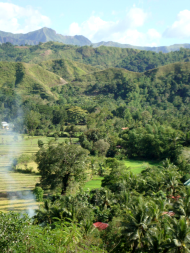Halo. Awoy. Lana.
“Nalat ako bato!”
Such an incomprehensible phrase, but Nanay Reg advised me to use it whenever an ati (or aeta) would ask money from us in the streets. The tagline simply means, “I have no money,” and it is more useful than walking away too fast to save your fruit shake from becoming a love-offering, or worse, pitching rude words.
Nanay Reg (Regibec in full) is a regular sidewalk vendor along Iznart Street, Iloilo City. Her vending booth consists of herbal concoctions and amulets that aetas are known for. She claimed that her products do not only cure physical ailments, but also disparities in spirit. “This can save you from the evil eye,” she said as she pointed to small red pockets that contain popular elements powerful enough to drive away negative essences.
I didn’t know if she was telling me to believe what she was selling, but on the back of my mind I was saying, “No need! I already do.” I have proven that those amulets and the lana (considered as a wonder oil) are indeed effective. It has become a part of my culture and my life, and I fully recommend these stuffs.
A native of the aeta community in Baranggay Kati-kati in the Province of Guimaras, Nanay Reg is proud of her origin, more so of her skin color. She never lamented over those stereotypes that fair-skinned individuals call her. Although she confessed that she once peppered a woman with bad luck after she was ruthlessly insulted. “I had patience, but she was way over my limit.”
Her afternoon is spent listening to news updates over her radio, waiting for potential buyers, and attending to her daughter’s needs. She started vending at 14, and now at 42, she is still hurdling over a low income, but enjoying an uncomplicated life. Back home, she is in-charge of preparing the meals, washing the clothes, and other household chores that are expected of a mother. Her husband is a truck driver and her kids are going to school, but not all of them. She wakes up early in the morning, maybe at four, and she prepares everything she needs in her business. She will ride on her motorbike going to Jordan wharf, and transfer to a pump boat that will carry her to Ortiz Wharf in Iloilo City. She admitted that many passengers already dislike her every time she is on board. “They did not want to sit beside me,” she recalled.
Her life at home is comparable to ours and so as to people who are making her skin color a serious issue. It is far from what I have read in books that aetas are nomads – moving from one place to another, and with no permanent residence. But Nanay Reg’s life has been totally different. She never experienced being a wanderer, nor did most members of her community. Though some traditions are already encoded in their culture, like the Pangayam (hunting for days), and having halo (monitor lizard) and ba-o (turtle) for diner. She also shared to me their ritual during Holy week, when they scale mountains to gather the various barks, leaves, roots, and seeds needed for charms and potions.
We had quite a long conversation that day, but I never thought that it would be more beneficial to me. I learned some interesting insights, such as the difference between Tuyaw and Usog. The former implies a curse by a soul, while the latter is a curse by a living mortal. Both can be relieved by a process, called Paluy-ahan, but a person can be protected from these mystic doings if he wears an amulet specifically intended for these.
But the most remarkable insight I got from her is the language that are unique to the aetas, and it is called the “Inati.” I never had imagined that they were able to craft their own vocabulary for thousands of years, which explains the nodding that I received when I talked to a 12-year old aeta kid at Jaro Plaza last month. Maybe I wasn't paying that much attention to my history subject before that's why I missed this one. The language was just so amazing that I had asked Nanay Reg to tell me, not only a word, but series of sentences. Here are some words that I caught:
Good Morning to you – Mayad ini aga kekyo
Good Evening to you - Mayad ini kelap kekyo
Thank you very much – Ribo ini salamat
My name is – Ako kay-i (name)
Yes – Awoy
No – Nalang
‘Twas five minutes past three and we had almost demanded more than an hour from Nanay Reg. I asked her a few more questions, and one of them was about the abortifacients that most people accuse them selling in their stalls. She pointed to a bottle that contain some pills. “These are camias. But these are for travel sickness and dyspepsia.” I asked her for another drug, though. “Cytotec? No, I don’t have any and I never sold one before. I have no plans.” She said. I knew this topic was somewhat uncomfortable to talk about, especially when I saw how her smirk turned an angle downward. She must have been badly affected by another vindictive typecast by most people regarding the acts of the aetas, especially that her heart and hands remained guiltless with these accusations.
I then asked her if kulam (witchcraft) is existing in her community, and she said yes. But she added that she is not willing to try it, especially that it can return a good amount of karma. I rushed on another query, and this time I asked her if her products are effective. She smiled and said, “All of these also need your faith. Believe that they will work, because they will.”
For the last few minutes, I made a follow-up question regarding what she did to the girl, who insulted her too much. “I do not want to do it again. I am not someone who will just punish a person for insulting me because I knew something strange. I can hold my patience even if people are already throwing a lot of verbal abuses to me…to us. I want to maintain a normal life; normal in a sense that people will not judge us because of how we look.”
I decided to end the conversation after I noticed that I got thirty minutes more from her. I thanked her and bade her good bye, and she responded at me with an enthusiastic smile and more polite greetings. I left with a jolly feeling and more awareness on a culture and a language that many people failed to understand.




















































